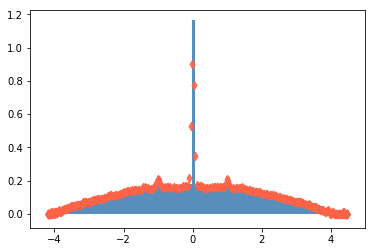eMaTe it is a python package which the main goal is to provide methods capable of estimating the spectral densities and trace functions of large sparse matrices. eMaTe can run in both CPU and GPU and can estimate the spectral density and related trace functions, such as entropy and Estrada index, even in directed or undirected networks with million of nodes.
pip install emate
If you a have a GPU you should also install cupy.
The Kernel Polynomial Method can estimate the spectral density of large sparse Hermitan matrices with a computational cost almost linear. This method combines three key ingredients: the Chebyshev expansion + the stochastic trace estimator + kernel smoothing.
import networkx as nx
import numpy as np
n = 3000
g = nx.erdos_renyi_graph(n , 3/n)
W = nx.adjacency_matrix(g)
vals = np.linalg.eigvals(W.todense()).realfrom emate.hermitian import tfkpm
num_moments = 40
num_vecs = 40
extra_points = 10
ek, rho = tfkpm(W, num_moments, num_vecs, extra_points)import matplotlib.pyplot as plt
plt.hist(vals, density=True, bins=100, alpha=.9, color="steelblue")
plt.scatter(ek, rho, c="tomato", zorder=999, alpha=0.9, marker="d")If the CUPY package it is available in your machine, you can also use the cupy implementation. When compared to tf-kpm, the Cupy-kpm is slower for median matrices (100k) and faster for larger matrices (> 10^6). The main reason it's because the tf-kpm was implemented in order to calc all te moments in a single step.
from emate.hermitian import cupykpm
num_moments = 40
num_vecs = 40
extra_points = 10
ek, rho = cupykpm(W.tocsr(), num_moments, num_vecs, extra_points)The problem of estimating the trace of matrix functions appears in applications ranging from machine learning and scientific computing, to computational biology.[2]
from emate.symmetric.slq import pyslq
import tensorflow as tf
def trace_function(eig_vals):
return tf.exp(eig_vals)
num_vecs = 100
num_steps = 50
approximated_estrada_index, _ = pyslq(L_sparse, num_vecs, num_steps, trace_function)
exact_estrada_index = np.sum(np.exp(vals_laplacian))
approximated_estrada_index, exact_estrada_indexThe above code returns
(3058.012, 3063.16457163222)
import scipy
import scipy.sparse
def entropy(eig_vals):
s = 0.
for val in eig_vals:
if val > 0:
s += -val*np.log(val)
return s
L = np.array(G.laplacian(normalized=True), dtype=np.float64)
vals_laplacian = np.linalg.eigvalsh(L).real
exact_entropy = entropy(vals_laplacian)
def trace_function(eig_vals):
def entropy(val):
return tf.cond(val>0, lambda:-val*tf.log(val), lambda: 0.)
return tf.map_fn(entropy, eig_vals)
L_sparse = scipy.sparse.coo_matrix(L)
num_vecs = 100
num_steps = 50
approximated_entropy, _ = pyslq(L_sparse, num_vecs, num_steps, trace_function)
approximated_entropy, exact_entropy(-509.46283, -512.5283224633046)

